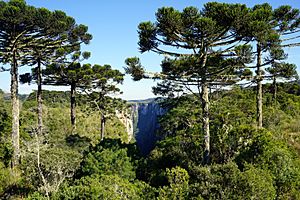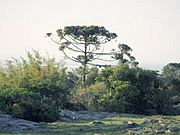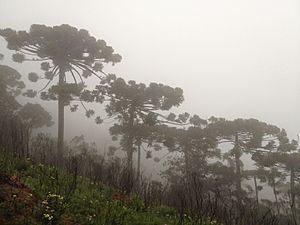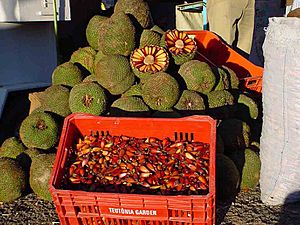Paraná pine facts for kids
Quick facts for kids Paraná pine |
|
|---|---|
 |
|
| Mature trees in Aparados da Serra National Park, Brazil | |
| Conservation status | |
| Scientific classification | |
 |
|
| Araucaria angustifolia distribution | |
| Synonyms | |
|
List
|
The Araucaria angustifolia, also known as the Paraná pine, Brazilian pine, or candelabra tree, is a special type of tree. In Portuguese, people call it pinheiro-do-paraná or araucária. Even though its common names include "pine," it's not a true pine tree. This amazing tree is part of the conifer family, but sadly, it is now a critically endangered species.
Contents
About the Paraná Pine
The Araucaria group of trees has been around for a very long time. They were part of Earth's plants even during the Triassic period, which was millions of years ago! Today, there are 19 different species of Araucaria trees, mostly found in the Southern Hemisphere.
Where Paraná Pines Grow
The Paraná pine used to cover a huge area of about 233,000 square kilometres (90,000 sq mi). But over time, about 97% of its natural home has been lost. This happened because of logging (cutting down trees), farming, and planting other types of trees.
These trees are native to southern Brazil. You can find them in states like Paraná, Santa Catarina, and Rio Grande do Sul. They also grow in some high-up areas of Minas Gerais, Rio de Janeiro, and São Paulo.
You can also find Paraná pines in other countries. They grow in northeastern Argentina (in Misiones and Corrientes). They are also found in parts of Paraguay (like Alto Paraná) and even in northern Uruguay. In Uruguay, people thought they were gone, but new discoveries have shown they are still there! These trees usually grow in low mountains, at heights between 500–1,800 metres (1,600–5,900 ft) above sea level.
What Paraná Pines Look Like
The Paraná pine is an evergreen tree, which means it keeps its leaves all year round. It can grow very tall, up to 40 m (130 ft) (about 130 feet). Its trunk can be as wide as 1 m (3 ft 3 in) (about 3 feet). The largest known tree is even taller, reaching 147.7 feet (45 m) (about 45 meters) in height! These trees grow quite fast.
The leaves are thick and tough. They are shaped like triangles, about 3–6 centimetres (1+1⁄8–2+3⁄8 in) long, and have very sharp edges and tips. These leaves stay on the tree for 10 to 15 years. This means most of the tree, except for the main trunk and older branches, is covered in leaves. The bark of the tree is also very thick, sometimes up to 15 centimetres (5.9 in) (6 inches) deep.
The Paraná pine is closely related to another tree called Araucaria araucana, which grows further southwest in South America. The main difference is that the Paraná pine has narrower leaves.
The inner bark and the sticky liquid (resin) from the trunk of the Paraná pine are reddish. This is a good way to tell it apart from A. araucana, which has brown inner bark and white resin.
Reproduction and Life Cycle
Paraná pines usually have male and female cones on separate trees. This means they are dioecious.
- Male cones: These are the pollen cones. They start about 6 cm (2.4 in) long and grow to 10–18 cm (4–7 in) long when they release pollen.
- Female cones: These are the seed cones. They are round and large, about 18–25 cm (7–10 in) across. They hold about 100 to 150 seeds.
The female cones take about 18 months to grow after pollination. When they are ready, they break apart to release the seeds. These seeds are like large nuts, about 5 cm (2 in) long. Animals, especially the azure jay bird, help spread these seeds.
Habitat and Ecology

Paraná pines like soil that drains well and is a little bit acidic. However, they can grow in almost any soil as long as water doesn't sit there. They need a warm, wet climate with plenty of rain. They can handle some cold weather, even frosts down to about −5 to −20 °C (23 to −4 °F).
The seeds of the Paraná pine are a very important food source for many native animals. Many mammals and birds eat the seeds, which are called pinhão in Portuguese. These seeds play a big role in the Araucaria moist forests, which are a type of Atlantic Forest in Brazil.
For example, a study showed that a type of squirrel called Guerlinguetus brasiliensis ssp. ingrami loves to eat these seeds. In the fall, Paraná pine seeds were the most important food for these squirrels. They also ate a lot of the seeds in winter. These squirrels sometimes bury seeds, which might help new trees grow.
How People Use Paraná Pines
The Paraná pine is a popular tree to plant in gardens in warm areas. People like its unique look, with its thick, "reptile-like" branches and very neat shape.
The seeds, which are similar to large pine nuts, are safe to eat. People in southern Brazil collect a lot of these seeds. This is especially important for the local native groups, like the Kaingáng. The seeds, called pinhão ([piˈɲɐ̃w̃]), are a popular snack in winter. The city of Lages in Santa Catarina even has a big pinhão fair where people enjoy mulled wine and boiled Araucaria seeds. About 3,400 tonnes (7,500,000 lb) of these seeds are collected in Brazil each year.
The wood from the Paraná pine is also used for building things like stair treads and joinery. People also use parts of the tree in folk medicine.
In Chile, the Paraná pine is planted in parks in cities like Santiago and Valdivia. It grows better in lower areas than the local Araucaria araucana, so it's used as a replacement there. In some places, like Melipeuco, you can even see both types of Araucaria trees growing next to each other.
There's also a special hybrid tree, which is a mix of Araucaria angustifolia and Araucaria araucana. Scientists think this hybrid first appeared in a tree farm in Argentina a long time ago. It's not a natural hybrid because the two original species grow very far apart in nature.
Protecting the Paraná Pine
The Paraná pine is in serious trouble. As mentioned before, it has lost about 97% of its natural home in the last 100 years. This is mainly due to logging and farming. Also, people eating the seeds might mean fewer new trees can grow.
Because of these threats, the IUCN (International Union for Conservation of Nature) first listed the Paraná pine as 'vulnerable' in 1998. Then, in 2008, its status was changed to 'critically endangered'. This means it is at a very high risk of disappearing forever if we don't protect it.
See also
 In Spanish: Pino del Paraná o Curí para niños
In Spanish: Pino del Paraná o Curí para niños






